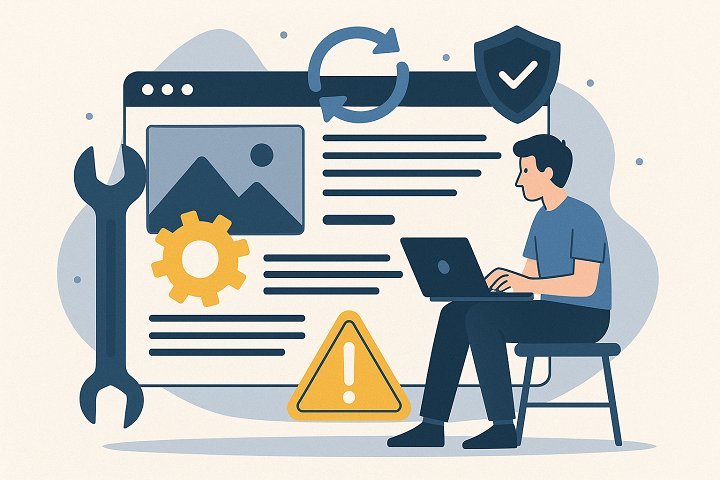In today’s digital world, website speed and performance are critical factors in ensuring user satisfaction, search engine ranking, and overall online success. A slow-loading website can lead to high bounce rates, poor user experience, and even loss of potential customers. One of the most effective ways to maintain optimal website performance is through regular website maintenance. In this article, we will explore the significance of website maintenance in boosting page speed and overall website performance, along with actionable steps to keep your site running efficiently.
Why Website Speed and Performance Matter
1. User Experience and Engagement
A slow website frustrates users and can drive them away before they even explore your content. Research shows that a website loading time of more than three seconds can result in a significant drop in engagement. A well-maintained website ensures a smooth user experience, leading to increased engagement and higher conversion rates.
2. SEO and Search Engine Rankings
Search engines like Google prioritize fast-loading websites in their rankings. Google’s Core Web Vitals, which include Largest Contentful Paint (LCP), First Input Delay (FID), and Cumulative Layout Shift (CLS), directly impact search rankings. Regular website maintenance helps optimize these factors, improving your website’s chances of ranking higher in search results.
3. Mobile Optimization
With an increasing number of users accessing websites via mobile devices, ensuring fast load times on mobile is crucial. A slow website on mobile can lead to a higher bounce rate and lower user retention. Website maintenance involves optimizing images, minimizing scripts, and improving server response times to enhance mobile performance.
4. Reduced Bounce Rate and Higher Conversions
Users tend to abandon slow websites quickly. A higher bounce rate negatively affects your website’s credibility and conversions. Regular maintenance ensures a seamless browsing experience, keeping users engaged and encouraging them to complete desired actions, such as making a purchase or signing up for a newsletter.
How Website Maintenance Enhances Page Speed and Performance
1. Regular Software and Plugin Updates
Websites, especially those built on CMS platforms like WordPress, rely on plugins and themes. Outdated plugins can slow down your website and pose security risks. Regular updates ensure that all components function optimally and do not interfere with website performance.
2. Optimizing Images and Media Files
Large image and media files significantly impact website load speed. Regular maintenance includes compressing images, using modern image formats like WebP, and implementing lazy loading to reduce page load time.
3. Minimizing HTTP Requests
Every element on a webpage (images, scripts, CSS files) requires an HTTP request. The more requests a website makes, the slower it loads. Website maintenance involves reducing unnecessary scripts, merging CSS files, and utilizing asynchronous loading techniques to speed up the site.
4. Caching Implementation
Caching stores frequently accessed website elements to reduce server load and speed up load times for returning users. Maintenance includes configuring browser and server caching to ensure faster content delivery.
5. Database Optimization
A cluttered database can slow down website performance. Regular maintenance involves cleaning up unnecessary data, optimizing database tables, and removing spam comments, expired transients, and old post revisions to enhance speed.
6. Content Delivery Network (CDN) Usage
A CDN distributes website content across multiple servers worldwide, reducing the time it takes for a page to load for users in different geographic locations. Routine maintenance ensures that your CDN settings are optimized and functioning properly.
7. Fixing Broken Links and Redirects
Broken links and excessive redirects can slow down a website and negatively impact SEO. Regularly checking and fixing these issues through maintenance improves website performance and user experience.
8. Enhancing Server Performance and Hosting Optimization
Your hosting provider plays a significant role in website speed. Maintenance includes monitoring server performance, upgrading to a faster hosting plan if necessary, and implementing server-level optimizations such as Gzip compression and HTTP/2.
Best Practices for Website Maintenance to Improve Speed and Performance
1. Regular Performance Audits
Conduct website speed tests using tools like Google PageSpeed Insights, GTmetrix, and Lighthouse. These audits help identify bottlenecks and areas needing improvement.
2. Update Website Technologies
Ensure that your website uses the latest versions of HTML, CSS, and JavaScript. Keeping your site’s core technologies up to date enhances security and performance.
3. Enable Lazy Loading for Images and Videos
Lazy loading ensures that images and videos load only when a user scrolls down to view them, reducing initial page load time and improving performance.
4. Implement Gzip Compression
Gzip compression reduces the file size of HTML, CSS, and JavaScript files, allowing them to load faster. Most modern hosting providers support Gzip compression.
5. Monitor Website Uptime and Downtime
Use monitoring tools like Uptime Robot or Pingdom to track website downtime and take corrective action immediately.
6. Secure Your Website
Cyberattacks and malware can slow down or even crash a website. Regular maintenance includes implementing security patches, SSL certificates, and firewall protection.
Conclusion
Website maintenance is an ongoing process that directly impacts page speed and overall performance. Neglecting maintenance can lead to slow load times, poor SEO rankings, and a frustrating user experience. By implementing regular updates, optimizing images, utilizing caching, and conducting performance audits, businesses can ensure their website remains fast, efficient, and user-friendly.
Investing time and resources in website maintenance not only boosts speed but also improves user engagement, search engine rankings, and conversions. Make website maintenance a priority, and your website will continue to deliver exceptional performance and seamless user experience.

